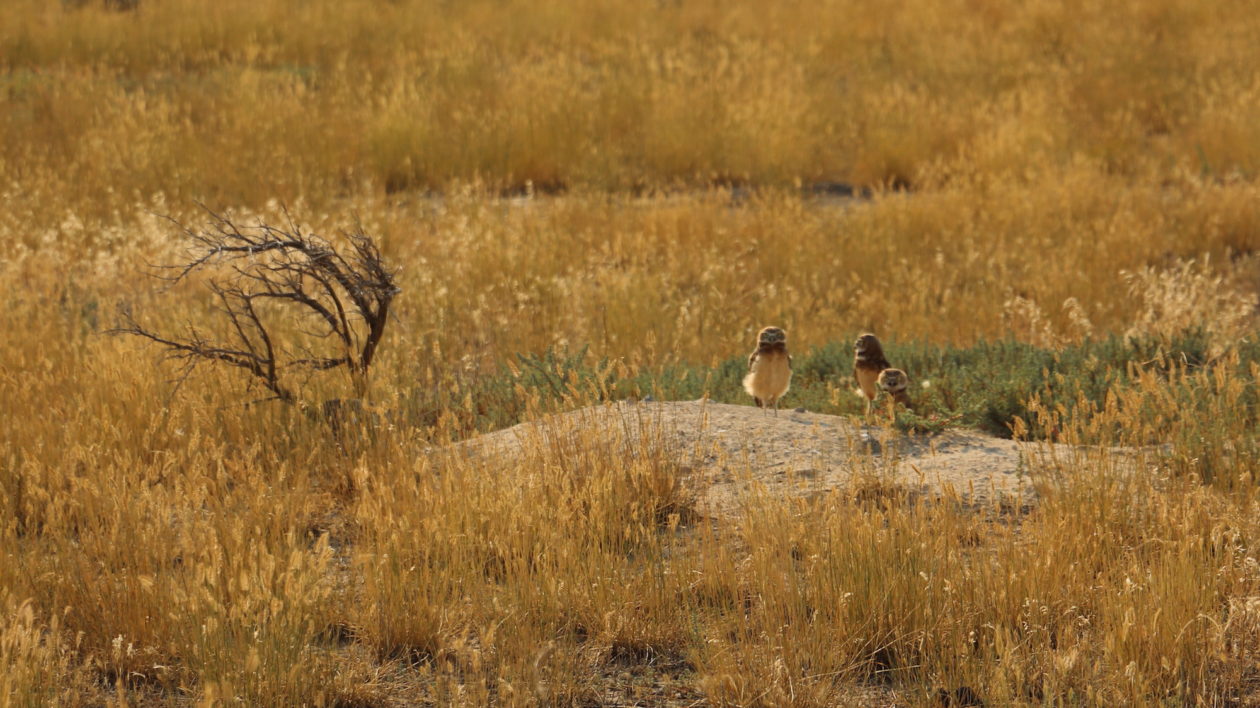Blacktop. White stripe. Sagebrush. Cheatgrass. The visuals whiz by my windshield in a smear that looks steamy, but it’s just a mirage. Rising heat waves are rippling the August scene. The intensity grows when smoke fogs the sun into an angry, red marble. I pull over thinking that will make a nice photo for a wildfire story.
I’ve driven this dry, desert stretch in every season. I’ve seen pronghorn on my right, elk on my left and a wolf ahead of my hood. I’ve seen all these animals in every season but summer. I’m certain wildlife abandons this desolate basin when the temperature induces sweat, but now I stand corrected.
As I frame the hot, hazy scene for a wide, landscape photo, something nearby flits at foot height. I pull my face away from my camera and watch the ground for more movement. A few seconds pass then a flash flusters powdery dirt several yards away. Jackrabbit? No. Too small. Vole? No. Too big.
I zoom my lens in on the settling dust and see a bouncing ball. Wait. Not a ball. A head. A milk-chocolate-colored one with ripe-banana-yellow eyes. I watch it bob, weave then strut onto a bare patch of earth in plain sight, but usually unnoticed because of it’s plain site. A burrowing owl. Shorter than my shin. Two more step out. I step away. They’re on to me so there’s no reason to hide, but I keep my distance so they’ll do their dance.

In this heat, the routine is short, but it’s a dandy before they retreat. Burrowing owls keep cool and covered by going underground. They’re squatters. They steal badger holes and call them home. Any hole holds possibilities really, that’s why scent-vent pipes are a predicament as revealed in Owls in the Outhouse.
“I hate to see some owl go down there, get stuck and get killed,” says Chris Colt, Caribou-Targhee National Forest wildlife biologist. “Or worse, be still alive and have to be fished out.”
Burrowing owls, the only owls that willingly spend time underground, prefer to steal homes, but unlike other owls poaching property, burrowing owls can also dig their own hide out. And they drag things to it. Other owls don’t do that.
“Most owls use what’s there, but burrowers bring stuff to their nest,” says Matt Larson, Owl Research Institute researcher. “They’ll shred cattle and bison dung and bring it to their burrows. That attracts insects to their nest and makes for easy forage.”
It takes a lot of hoppers to keep an owl fed. Voles are bigger meals. When those decline, owls decline. The Owl Research Institute started studying owls in 1987 and most species are declining.
“One of our Missoula study sites is 31 years old and part of it is now a golf course so there’s loss of habitat,” Larson says. “But in other study areas, there’s more protection so it’s hard to say it’s one issue.”
The burrowing owl population is down about 35 percent since the 1970s. Watching this active and curious family in the desert is encouraging if a bit uncomfortable. They’re close to the interstate. Maybe too close. Traffic races passed us. I’m sure drivers see me and wonder what is lens-worthy, but there’s no way they see what’s entertaining me. I’m glad I stopped for that wildfire shot. I’ve never seen burrowing owls out here until now. Never even thought to look for the delightful little show on the side of the road that will make you laugh should you slow down long enough to watch.
Did you know?
An owl’s eyes are fixed in its skull. That’s why the whole head turns to look left and right. While eyes account for only one percent of a human head, they make up 31 percent of an owl’s.



I loved the video and your narrative. Thanks!
I wish that people would slow down and actually take the time to enjoy the wildlife. Im amazed with all animals, just wish everyone else was. Great article. I learned something that I did not know!
Delightful & knowledgeable report on seldom seen creatures! Thanks!
Great video – such beautiful little creatures. Its amazing they exist so close to a highway – would think it would discourage them. On the other hand – if no one is aware of them – I guess they feel safe.
Thanks – really enjoyed this.